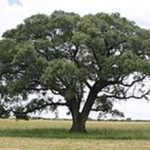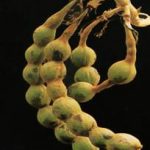TREE LIFE
September 2012
MASHONALAND CALENDAR
September 13th-16th: Trip to Hippo Pools for those who have already signed up.
September 22nd (4th Saturday): Visit to the Chenaud-Repond’s garden in Sentosa. Details to follow by email.
In September 2012 Dr. Tom Mueller has a special birthday, which the Tree Society is planning to celebrate with a lunch in the Botanic Gardens on 21st October. Please keep this date in your diaries. Details to follow in early October.
TREE SOCIETY VISIT TO CATAPú, SOFALA, MOZAMBIQUE Friday, April 6th – Sunday, April 15th, 2012
Episode 5
Excursion to Inhamitanga Forest and Mary Livingstone’s grave
This was the highlight for me because my real passion is evergreen gallery forest. We left Mphingue Lodge at Catapú, where Meg has done amazing work identifying and cataloguing over 300 species characterised as dry deciduous, lowland forest. Turning off the EN1 we turned down towards Inhaminga village and then on to the District road 213 to Lacerdonia. Unashamedly I refer to the article in Honeyguide by G. Davies et al, who rave about this forest as “the largest indigenous forest in Mozambique”, which they estimate covers 40 000 hectares with further outliers on Coutada 12 (a hunting area), Shupanga and on Catapú West of the Chissadze River. The article says that the road between Inhamitanga and Lacerdonia “must be one of the finest roads for a naturalist in Mocambique”. Still quoting the article, the flora of Inhamitanga Forest has been briefly described by Burrows et al (1998) and Muller et al (2005) as characterised by both evergreen and deciduous tree species e.g. Celtis mildbraedii, Drypetes gerrardii, Suregada zanzibariensis, Chrysophyllum viridiflorum, Afzelia quanzensis, Cordyla africana, Millettia stuhlmannii, Xylia torreana, Blighia unijugata, Sterculia appendiculata, Milicia excelsa and Morus mesozyga.
We made three stops along this magnificent drive, the first in tall deciduous forest near the turnoff to the Envirotrade camp. Mark was in hot pursuit of the botanical equivalent of the avian LBJ’s (little brown jobs), at which he excels and which are at least accessible for identification. The evergreen forest begins about 17kms from Inhamitanga and continues for the next 15kms before opening up to thickets and low canopied forest. The soils are sandy and rainfall is 1000 – 1200mm, with some winter rainfall and winter mists. We could only marvel at the magnificent trees on our next few stops and frustratingly were not able to positively identify these tall trees. Meg had shown us a Celtis mildbraedii next to her Herbarium at Catapú, with rounded, irregular teeth on the upper part of the leaf and very pronounced buttresses. Those in the forest would reach 30 metres in height. At our final stop Meg pointed out a big Ficus bubu with a strangle hold on its barely-surviving host tree. Strangely the literature describes it as “a tall tree up to 30 metres high with a straight trunk, sometimes developing stilt roots, occurring in low altitude evergreen forest” with no mention of it being a strangler.
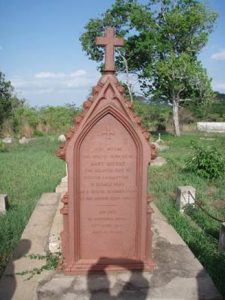
Grave of Mary Moffat, Shupanga, Mozambique. Photo: Wikipedia
We now entered degraded forest with village cultivation (mashambas) before reaching Shupanga and the short drive down to the graveyard. Close by is the Catholic Church, roofless when I was last there, but now restored. A few hundred metres through the rank grass we had to fight our way through the gate and make our way to the grave. The grave itself is raised and used to have a chain fence around it. The headstone is cast iron, on one side English and the other Portuguese and showing obvious signs of deterioration. The inscription reads:
“Here repose the remains of Mary Moffat the beloved wife of Dr. Livingstone. In humble hope and joyful resurrection in our Saviour Jesus Christ. She died in Shupanga house on 27th April 1862, aged 41”. The connection to the Meikle family is that Mary Moffat was the daughter of Robert Moffat, famed missionary at Kuruman in South Africa. Robert Moffat’s grandson H.U. Moffat, the first Prime Minister of Rhodesia, married Marion Meikle, my Great Aunt. How sad that the final resting place of Mary Moffat is in a neglected graveyard on the banks of the Zambezi, while her famous husband lies in the splendour of Westminister Abbey. The 29th April 2012 was the 150th Anniversary of her death.
-John Meikle
Mammals of Catapú
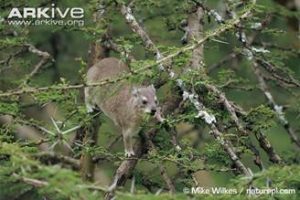
Tree Hyrax. Photo Arkive
Nobody who spends more than a few nights at M’Phingue Lodge at Catapú will forget the spine chilling nocturnal vocalisations of the tree hyrax. Smithers aptly describes the call as an “orgy of mass murder”. This little nocturnal mammal is related to elephants and aadvarks. They have 4-toed front feet and 3-toed back feet with rubbery soles that help them climb. They may also be encountered basking on a tree in the heat of the day.
Red duikers (both males and females are horned) and suni (only males are horned) are treasured sightings, the former being an almost daily sighting between our group of dendrologists. These small antelope are water independent and love eating succulent young panga panga shoots to meet their water requirements, making it imperative to protect young saplings in a structure called a gate until they are old enough to have lost their juicy trunks. Blue duiker are also present but appear to be much rarer.
All five primates are present on Catapú: Samango, Vervet and Chacma Baboon, as well as the nocturnal Lesser Galago (nagapie) and Greater Galago (bush baby) which can be heard at night. Another secretive nocturnal special that is very under-studied due its rarity is the bushy tailed mongoose.
Nyala, kudu and impala occur in small numbers in the forest and Ant White informed us that lion and elephant migrate between the Zambezi and Gorongoza. In fact there are some scary tales of bird watchers stepping on loaded lion traps in some parts of Sofala! Meg has also seen African Wild Dogs on the road in the Inhamitanga forrest.
Both red and sun squirrels were seen during our stay and the forest habitat is very congenial to warthog, bushpig and porcupine. In fact the highest concentration of warthog I have ever encountered occurs in the Gorongoza National Park, which is a worthwhile stop over en route to Catapú. We overnighted at a camp just before the park entrance gate, run by Piet van Zyl who specialises in taking people up Gorongoza Mountain, which is also outside the park. The mountain is famous for its good population of green-headed oriole.
-Karl van Laeren
Some of the special trees at Catapú
Although Catapú is some 150 km from the coast the altitude is mostly less than 100 m above sea level on sandy and sandstone derived soils. From a vegetation perspective the area falls within the Swahilian/Maputaland Regional Transition Zone with some trees occurring both to the North into East Africa and some occurring in South Africa and some going in both directions.
M’piao, whose scientific name Ant White couldn’t remember, is Inhambanella henriquesii, the tall evergreen tree standing proud when we went to see the GAIT (Grow an Indigenous Tree) project. Inhambanella, which belongs to the family Sapotaceae, is what is known as a monotypic genus, as it only has one species, henriquesii. The name Inhambanella come from Inhambane in Mozambique where the type specimen was collected by M. Ferriera. Júlio Augusto Henriques (1838-1928), was a Portuguese botanist, professor at the University of Coimbra and director of their botanic garden. He revived and developed the field of science in his country, collecting extensively and writing methodical floras for several regions of Portugal. A keen plant collector himself, this promoter of Portuguese botany travelled all over the country in search of specimens to develop the university’s herbarium. Although he also visited West Africa, he never visited Mozambique. M’piao occurs in coastal regions from South Africa, where it is known as the milk pear, to Tanzania and Kenya. If we had been able to reach the leaves we would have seen that they were spirally arranged and crowded at the ends of the branches and had a milky sap.
Another species with milk but this time with leaves in whorls, we first saw in the Inhamitanga Forest was Rauvolfia mombasiana. The type specimen was collected at Chupanga, (where we went to see Mary Livingstone’s grave) in 1863. I was very excited when it was found on the banks of the Tissadze River on that last Friday afternoon walk as this is the first time it has been collected at Catapú. This is related to the quinine-tree, Rauvolfia caffra and in Kenya the bark is used for poisoning rats and a root decoction is reported to be a remedy for malaria. It also occurs in northern Mozambique and Tanzania.
It is Millettia stuhlmannii, of course, which provides the timber panga-panga. This occurs from Maputo to Tanzania with a very small population creeping into South Africa and a few small populations in Zimbabwe. It is being exploited for the timber throughout its range. Fortunately it coppices very readily and at Catapú the coppice growth is being managed reducing the coppice shoots to one or two until after three years it is left to grow on its own. It is hoped that this will reach sufficient size to provide timber after about 60 years.
Millettia mossambicensis, has an even more restricted range, recorded from Gorongosa National Park to SE Tanzania. This was the tree, often quite small, with the undersurface of the leaflets densely silky.
Those of us who walked up the slope of the borrow pit after admiring the M’piao saw Zanthoxylem holtzianaum. This belongs to the citrus family Rutaceae and is quite unmistakable with conical spine-tipped bosses up to 5 cm in diameter on the trunk and pellucid gland dots like those found in lemon and orange leaves. There are not very many of them around at Catapú. This only the second time I have seen it and they do not seem to have recorded south of the Zambezi River before.
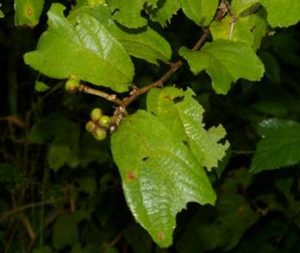
Grewia truncata fruit
Another bonus for me was finding Grewia truncata in fruit. It was only recently that I realised that we had it at Catapú. In the past I confused it with Grewia sulcata, which also has white flowers. It has the most amazing leaves which are described as having a truncate (cut off more or less squarely) or retuse (notched) apex. The margin of the leaves is very coarsely toothed and they look for all the world as though something has taken a jagged bite out to the end of the leaf. It is almost unbelievable that this is natural. This has been recorded from Malawi and northern Mozambique and is another first for south of the Zambezi River.
There are lots of different species of Grewia at Catapú and another one not previously recorded from south of the Zambezi River is Grewia forbesii. We saw this on the first day on the edge of the borrow pit. This is closely related to the well-known donkeyberry, Grewia flavescens with square stems but is more robust and the fruit are warty. On the yellow flower there is a distinct purple ring at the base of the stamens.
Closely related to the Grewias is Glyphea tomentosa, which we found on the walk in the Tissadze River bed up-stream from the via Lavu crossing where we had parked the cars on Thursday morning. It was in flower but the flowers didn’t seem to be opening the same way that those of Grewia do and then someone spotted a fruit, which is quite different. It is woody, oblong-cylindrical, about 5-6 cm long, softly hairy, with eight to ten paired deeply incised ridges running longitudinally down the outside.
Much further along the Tissadze was Ficus lingua, small-leaved fig, a strangler reaching up into the canopy and we had to be content admiring the leaves through binoculars as there were no volunteers to climb up and bring some down. During that walk we also saw Ficus bussei, Zambezi fig, unmistakable with the lobes at the base of the leaf overlapping. (The fig we walked through on the Suni N path is also the Zambezi Fig, whatever the label said). Further upstream Karl found a Ficus sycomorus, which I thought was a new record and some people went back to get the GPS reading for me, but I find I have recorded it before about 9 km along the EN1 towards Caia. So I am very happy with this record. Again thanks to Karl, on Friday in the forest adjacent to via Pungue we found a specimen of what is probably Ficus tremula. The leaves have very long petioles and presumably shimmer in the wind giving rise to the name ‘’tremula’’. We haven’t had a chance to confirm the identification in the herbarium yet. I do know of one so it was good to find another.
Erythrina livingstoniana became a huge favourite, despite being well armed with scattered wood bosses tipped with spines up to 2,5 cm long. There are two planted on the lawn in front of Mpingue, so everyone saw them. We also found one during our Suni N walk on Thursday afternoon. This is another species with a very restricted distribution being more or less confined to the Zambezi and Save catchment areas of Zambia, Malawi, Mozambique and Zimbabwe. The type specimen was again collected by Dr John Kirk, 96 km up the Shire River.
I would like to thank everybody who came to Catapú, for coming and for their contribution to the enjoyment of the trip. You will see from my previous remarks what a huge difference it made having so many extra pairs of eyes. I am delighted with all we saw and found. And thank you Richard for the bird list. A special thanks to Mark and Isla for all their help sorting out the herbarium, a job which on my own would have taken a week. Thank you to Mark for recording all he saw. This will make a very big addition to the known vegetation diversity at Catapú. A very big thank you to Ant for the time he spent showing us and sharing his Catapú. Finally thanks to the staff a Mpingue who fed and looked after us so well.
-Meg Coates Palgrave
TO BE CONTINUED………..
TREE OF THE MONTH
Acacia karroo
Family: – Fabaceae – Mimosoideae
Down under it might be called Vachellia karroo but I will stick to the name “Acacia”, after all the first specimen (Acacia nilotica) was described by Carl Linnaeus in 1773 in Africa. Common names: – Sweet thorn; Nd: Isinga; Sh: Munenje.
The Fabaceae are very numerous so they have been subdivided into Mimosoideae, Papilionoideae and Caesalpinoideae. In the “Field guide to the Acacias of Zimbabwe” (Jonathan Timberlake et al) 43 acacias are described.
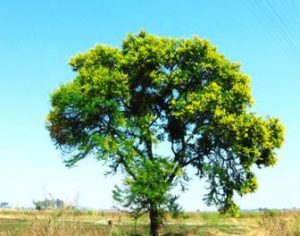
Acacia karroo
Acacia karroo is possibly the most widespread and the most showy of them all when in flower It is a small to medium-sized tree, mostly single-stemmed with a rounded crown.
The bark on mature trees is rather coarse and fissured longitudinally, dark-grey to black in colour with a tinge of red from the under-bark.
The leaves are bipinnate with 2 to 6 pinna and 8 to 16 leaflets pairs per pinna, the leaflets are small but do not overlap, they are also greener and shinier than most.
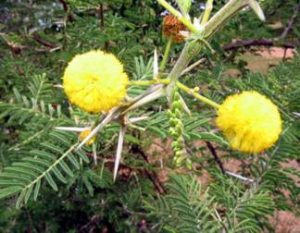
Acacia karroo showing spines and pom pom flowers
The thorns, paired at the nodes, are straight and white with a brownish tip. The thorns are actually modified stipules, straight and paired at the nodes.
The inflorescence, from December to March, is spectacular. What we call the “flower” is in fact an aggregate of tiny individual petal-less tiny flowers. They are sweet scented and occur in a profusion of aggregate globose “flowers”. Pollination is done by insects.
The pods are dehiscent slender, sickle shaped narrow beans somewhat constricted between individual seeds. The pods and the foliage are relished by wild animals (black rhino, giraffe, eland, kudu, sable, impala) and by livestock.
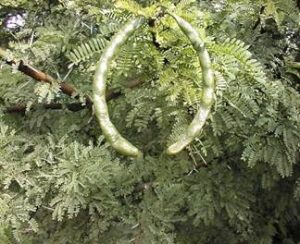
Acacia karroo pods
The tree produces a sweet resin that is very palatable and can compete with the gum of Acacia senegal. Once upon a time the gum was exported as “Gomme du Cap”. A local NGO, Bio-Innnovation Zimbabwe, is presently trying to get it recognised as an acceptable alternative to Gum Arabic, the globally sought-after product from mainly Somalia that is used in the confectionary industry.
The tree could easily be used in agro-forestry in the dryer parts of this country, combined with beehives and the production of fodder. The seeds germinate easily if soaked in hot water or scarified some other way, and transplant well in a wide variety of soils. It is both drought and frost resistant. Another interesting feature of Acacia karroo (and other Leguminosae) is that they fix atmospheric nitrogen. As a pioneer in soil reclamation it has great potential.
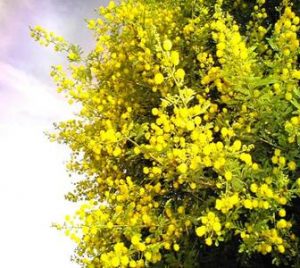
Acacia karroo in flower
The tree is relatively fast growing (around 1m a year) but rarely exceeds 35 years of age. The wood is heavy (800 to 900 kg per cubic metre) and burns well. The wood is unfortunately not very durable being very prone to borer attacks. The tree coppices readily and makes a good charcoal.
The bark contains 19% tannin and is useful in tanning, giving leather a reddish-brown colour. The inner bark makes good ropes. The tree also has medicinal uses. Of interest to our more senior readers, the seeds are chewed as an aphrodisiac and the bark and roots are used for various digestive system ailments.
Bibliography:
Timberlake et al. Acacias of Zimbabwe, the Acacia handbook.
B. Goldsmith and D.T. Carter. The Indigenous Timbers of Zimbabwe.
Nico Smit. Guide to the Acacias of South-Africa.
Fanie & Julye-Ann Venter. Making the most of Indigenous trees.
Ben-Erik Van Wyk et al. Medicinal plants of South-Africa.
-JP Felu
Outing to Mharapara Farm, Goromonzi – 19th August 2012
Mrs. Carol Reed, who lives at Mharapara Farm on the Goromonzi Road, invited the Tree Society to visit the farm, which had many years ago been a game reserve belonging to the well-known surgeon Mike Standish White. Meg led the outing. We met on a windy Sunday morning, feeling more chilly than expected, and I was surprised to count at least 26 people, of whom seven were under fifty, which might be a record for the present-day Tree Society. We had at least three first timers, who were a pleasure to welcome. When I say ‘at least 26’ my numbers were a little vague because members of the Tree Society are all individuals with their own agendas, so it was difficult to catch them all in one place at one time to count them! At one point the outing also included three children and two dogs.
The game reserve area borders a stream and goes down beyond a small dam that is filled in the dry season by an ancient, still-efficient ram pump, which must have provided water for the game in the past. The area has not been cultivated and at the top near the house Standish White had planted many of the well-loved Zambezi Valley species. We found such trees as Garcinia huillensis and Trichilia emetica (actually planted in the garden), Acacia xanthophloea, Khaya anthotheca, Acacia erioloba, Kigelia africana, and Albizia sp. (possibly glaberrima), all of which are good garden specimens but unexpected in the wild on the Highveld.
Going further down towards the stream we found at least 19 Highveld species, including numerous Syzygium sp. (probably the intermediate variety) which were the greenest trees in the valley with their lovely shiny leaves, as well as Combretum molle, Uapaca kirkiana, Julbernardia globiflora, Brachystegia spiciformis and B. microphylla, Faurea rochetiana and F. saligna, Parinari curatellifolia, Searsia (formerly Rhus) longipes, Vernonia colorata, Dombeya rotundifolia, Myrsine africana, Euclea crispa, Gymnosporia senegalensis, the glorious red of Erythrina abyssinica (with its thin white line along the bottom of the longest red petal that distinguishes it from E. lysistemon), Protea angolensis and lastly Vangueriopsis lanciflora. There were numerous Dodonea viscosa, some with long heads of four-winged seeds, and a couple of the small yellow legume Sphenostylis erecta (African yam bean). We also found one specimen of Inula glomerata (Hare’s ears) that grows as one single leaf straight out of the ground.
We warmed up as we dropped down through the woodland towards the dam and were more protected from the wind, which was a welcome change. Bilal the observant spotted several sundew plants (Drosera sp.) growing down by the water. The area wasn’t particularly diverse in terms of species, but very pleasant to wander through, especially at this time of the year with the show of colour from the early Brachystegias with their new leaves, the burnt orange of the Faurea rochetiana leaves, the white Dombeya flowers and of course the scarlet Erythrina.
The group retired to the sunny garden for lunch and made up a large group under the trees. A generous neighbour had given a huge bucket of gorgeous fresh strawberries to Carol when she heard the Tree Society were visiting, and some went home with luscious pockets full ! I think I can say that a very good time was had by all, thank you to Carol for a delightful day.
– Isla Grundy


